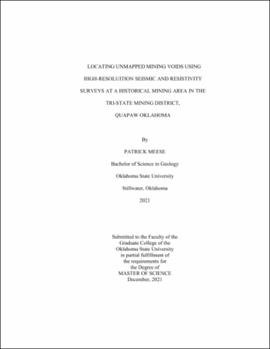| dc.contributor.advisor | Ismail, Ahmed | |
| dc.contributor.author | Meese, Patrick | |
| dc.date.accessioned | 2022-05-13T19:05:16Z | |
| dc.date.available | 2022-05-13T19:05:16Z | |
| dc.date.issued | 2021-12 | |
| dc.identifier.uri | https://hdl.handle.net/11244/335776 | |
| dc.description.abstract | The Tri-State Mining District in northeast Oklahoma has been heavily undermined, leaving both large and small manmade void spaces that pose a danger to both property and human life. The district is classified as the Tar Creek Superfund Site due to the combined hazards of toxic levels of zinc, cadmium and lead in mine waste, soil, air, and water. The underground voids present an additional hazard for subsidence due to extensive undermining. This study tested the effectiveness of the seismic land streamer and resistivity Ohm Mapper geophysical tools for providing high-resolution seismic and electrical resistivity images of mining voids at the study site. The seismic land streamer and resistivity Ohm Mapper were selected in this study because they enable rapid data acquisition with minimum interaction with the ground surface and require a small crew to acquire data. The acquired seismic data were analyzed as P-wave reflection, refraction, and multichannel analysis of surface wave. These were used to generate multiple profiles of the subsurface and maximize the chance of detecting mining voids. The results showed that the Ohm Mapper resistivity images were ineffective in detecting mining voids due to the high noise level in the data and the limited imaging depth. However, the seismic land streamer images successfully detected multiple mining voids along the acquired profiles. This study of the Tar Creek Superfund Site demonstrated that a seismic land streamer is an effective tool for acquiring suitable data to characterize subsurface voids. | |
| dc.format | application/pdf | |
| dc.language | en_US | |
| dc.rights | Copyright is held by the author who has granted the Oklahoma State University Library the non-exclusive right to share this material in its institutional repository. Contact Digital Library Services at lib-dls@okstate.edu or 405-744-9161 for the permission policy on the use, reproduction or distribution of this material. | |
| dc.title | Locating unmapped mining voids using high-resoluition seismic and resistivity surveys at a historical mining area in the Tri-State Mining District, Quapaw, Oklahoma | |
| dc.contributor.committeeMember | Puckette, Jim | |
| dc.contributor.committeeMember | Halihan, Todd | |
| osu.filename | Meese_okstate_0664M_17500.pdf | |
| osu.accesstype | Open Access | |
| dc.type.genre | Thesis | |
| dc.type.material | Text | |
| thesis.degree.discipline | Geology | |
| thesis.degree.grantor | Oklahoma State University | |
